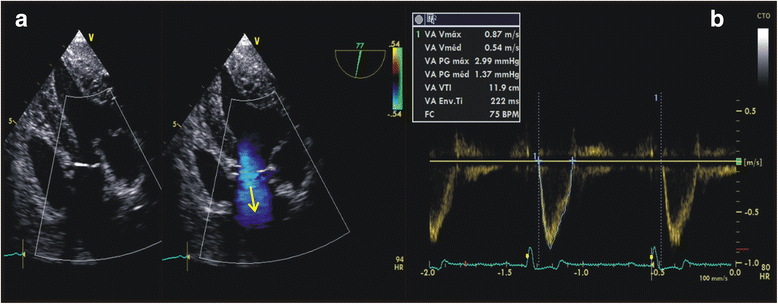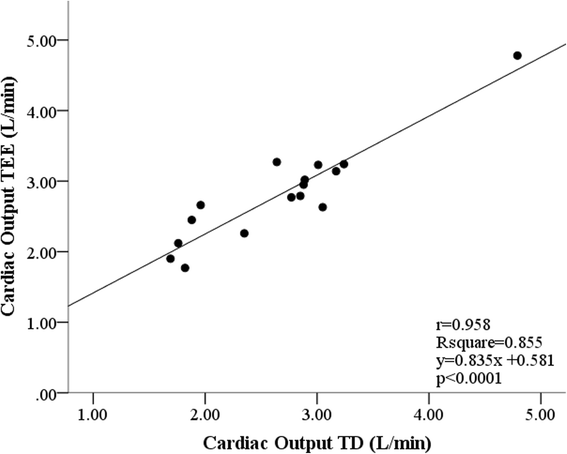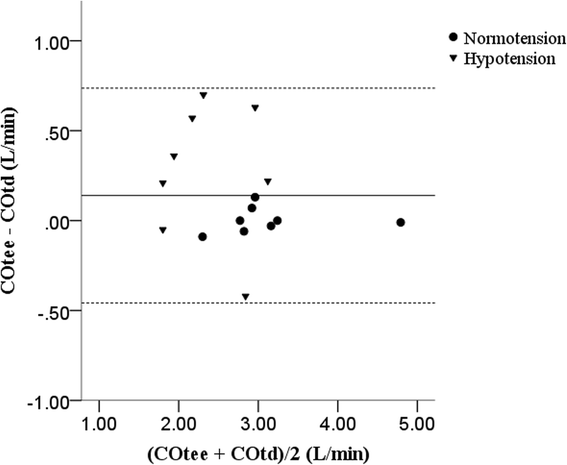Clinical monitoring of cardiac output assessed by transoesophageal echocardiography in anaesthetised dogs: a comparison with the thermodilution technique
- PMID: 29121915
- PMCID: PMC5679384
- DOI: 10.1186/s12917-017-1227-9
Clinical monitoring of cardiac output assessed by transoesophageal echocardiography in anaesthetised dogs: a comparison with the thermodilution technique
Abstract
Background: Cardiac output (CO) is an important haemodynamic parameter to monitor in patients during surgery. However, the majority of the techniques for measuring CO have a limited application in veterinary practice due to their invasive approach and associated complexity and risks. Transoesophageal echocardiography (TEE) is a technique used to monitor cardiac function in human patients during surgical procedures and allows CO to be measured non-invasively. This prospective clinical study aimed to compare the transoesophageal echocardiography using a transgastric view of the left ventricular outflow tract (LVOT) and the thermodilution (TD) technique for the assessment of CO during mean arterial pressure of 65-80 mmHg (normotension) and <65 mmHg (hypotension) in dogs undergoing elective surgery. Eight dogs were pre-medicated with acepromazine (0.05 mg/kg, IM), tramadol (4 mg/kg, IM) and atropine (0.03 mg/kg, IM), followed by anaesthetic induction with propofol (3-5 mg/kg IV) and maintenance with isoflurane associated with a continuous infusion rate of fentanyl (bolus of 3 μg/kg followed by 0.3 μg/kg/min). The CO was measured by TEE (COTEE) and TD (COTD) at the end of expiration during normotension and hypotension (induced by isoflurane).
Results: There was a strong positive correlation between COTEE and COTD (r = 0.925; P < 0.0001). The bias between COTD and COTEE was 0.14 ± 0.29 L/min (limits of agreement, -0.44 to 0.72 L/min). The percentage error of CO measured by the two methods was 12.32%. In addition, a strong positive correlation was found between COTEE and COTD during normotension (r = 0.995; P < 0.0001) and hypotension (r = 0.78; P = 0.0223).
Conclusions: The results of this study indicated that the transgastric view of the LVOT by TEE was a minimally invasive alternative to clinically monitoring CO in dogs during anaesthesia. However, during hypotension, the CO obtained by TEE was less reliable, although still acceptable.
Keywords: Aortic flow; Doppler; Minimally invasive; Swan Ganz; Transgastric.
Conflict of interest statement
Ethics approval and consent to participate
The study was authorized by written consent of the owners and the protocol (1936/2012) was approved by the university’s ethical committee in the use of animals (CEUA).
Consent for publication
Not applicable.
Competing interests
The authors declare that they have no competing interests.
Publisher’s Note
Springer Nature remains neutral with regard to jurisdictional claims in published maps and institutional affiliations.
Figures




Similar articles
-
Evaluation of an oesophageal Doppler device for monitoring cardiac output in anaesthetised healthy normotensive dogs.J Small Anim Pract. 2015 Jul;56(7):450-5. doi: 10.1111/jsap.12362. Epub 2015 Apr 24. J Small Anim Pract. 2015. PMID: 25913545
-
Accuracy of cardiac output measurements with pulse contour analysis (PulseCO) and Doppler echocardiography during off-pump coronary artery bypass grafting.Eur J Anaesthesiol. 2008 Mar;25(3):243-8. doi: 10.1017/S0265021507002979. Epub 2007 Nov 9. Eur J Anaesthesiol. 2008. PMID: 17996125
-
Transoesophageal echocardiography accurately detects cardiac output variation: a prospective comparison with thermodilution in cardiac surgery.Eur J Anaesthesiol. 2008 Feb;25(2):135-43. doi: 10.1017/S0265021507001354. Epub 2007 Aug 2. Eur J Anaesthesiol. 2008. PMID: 17672920
-
Cardiac output in 1998.Heart. 1998 May;79(5):425-8. doi: 10.1136/hrt.79.5.425. Heart. 1998. PMID: 9659184 Free PMC article. Review. No abstract available.
-
Cardiac output measurements via echocardiography versus thermodilution: A systematic review and meta-analysis.PLoS One. 2019 Oct 3;14(10):e0222105. doi: 10.1371/journal.pone.0222105. eCollection 2019. PLoS One. 2019. PMID: 31581196 Free PMC article.
Cited by
-
Intraoperative Protective Mechanical Ventilation in Dogs: A Randomized Clinical Trial.Front Vet Sci. 2022 Mar 15;9:842613. doi: 10.3389/fvets.2022.842613. eCollection 2022. Front Vet Sci. 2022. PMID: 35372547 Free PMC article.
-
Real-Time Monitoring of Cardiac Output Using Non-Invasive Impedance Cardiography in Dogs: A Pilot Study on Heartworm Extraction and Gastric Decompression.Vet Sci. 2025 May 15;12(5):478. doi: 10.3390/vetsci12050478. Vet Sci. 2025. PMID: 40431571 Free PMC article.
-
Clinical Application of the Fluid Challenge Approach in Goal-Directed Fluid Therapy: What Can We Learn From Human Studies?Front Vet Sci. 2021 Aug 3;8:701377. doi: 10.3389/fvets.2021.701377. eCollection 2021. Front Vet Sci. 2021. PMID: 34414228 Free PMC article. Review.
-
Interventional Heartworm Extraction in Two Dogs: The Clinical Application of Impedance Cardiography.Animals (Basel). 2023 Oct 7;13(19):3127. doi: 10.3390/ani13193127. Animals (Basel). 2023. PMID: 37835733 Free PMC article.
-
Agreement between transthoracic echocardiography and esophageal Doppler on aortic flow variables in anesthetized mechanically ventilated dogs.Can Vet J. 2022 Jul;63(7):722-726. Can Vet J. 2022. PMID: 35784775 Free PMC article.
References
-
- Gonzalez J, Delafosse C, Fartoukh M, Capderou A, Straus C, Zelter M, Derenne JP, Similowski T. Comparison of bedside measurement of cardiac output with the thermodilution method and the Fick method in mechanically ventilated patients. Crit Care. 2003;7(2):171–178. doi: 10.1186/cc1848. - DOI - PMC - PubMed
Publication types
MeSH terms
Substances
LinkOut - more resources
Full Text Sources
Other Literature Sources

